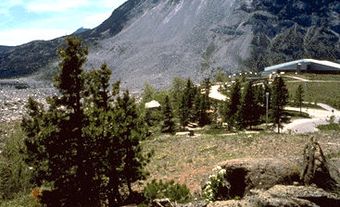Magnetic Poles
Because it behaves like a magnetized sphere, Earth has 2 magnetic poles. They are located near, but not at, the geographic poles, which are on the axis of Earth's rotation.
The north and south magnetic poles are the locations on Earth's surface where the planet's magnetic field points straight downwards (at the north magnetic pole) and upwards (at the south magnetic pole). Conventional compasses which move on a horizontal plane are useless near the magnetic poles. However, a magnetized needle free to swing vertically will dip downwards at the north magnetic pole and point straight up at the south magnetic pole. For this reason, the magnetic poles are also referred to as the "dip poles."
Geomagnetic Poles
Geophysicists also use the term geomagnetic poles, whose locations are determined by a mathematical analysis of Earth's overall magnetic field, making the assumption that it acts as a perfect bar magnet. The north geomagnetic pole is currently located in KANE BASIN between Ellesmere Island and Greenland. The south geomagnetic pole is in Antarctica. Their locations are theoretical and cannot be detected by a compass or other instruments on the ground. When Earth is viewed from space, the geomagnetic poles mark the centre of an oval-shaped region where auroras most frequently occur (see NORTHERN LIGHTS).
An Iron Mountain
The nature of the magnetic poles has perplexed explorers and geographers for centuries since their locations affect the accuracy of compass navigation. Early Arab mariners believed compass needles were attracted to an iron mountain at the NORTH POLE. With the advent of the sextant for fixing a position by the stars, navigators came to realize there was a difference between geographic (true) north and magnetic north. The Flemish mapmaker, Gerardus Mercator, tried to explain variations in this angle, known as magnetic declination, by locating 2 north magnetic poles, 500 km apart, on his map of the Arctic published in 1569.
Then in 1600, William Gilbert, personal physician to Queen Elizabeth I, put forward the revolutionary idea that Earth itself is a huge magnet, with north and south magnetic poles. He was right, in that a compass needle reacts to forces deep within the Earth, although we now know Earth's magnetism is far from static. Scientists now believe Earth's magnetic field is generated by the flow of molten, iron-rich minerals in Earth's outer core. So Earth behaves more like an unpredictable electromagnet, rather than a simple bar magnet as Gilbert thought.
Always On the Move
An intriguing feature of the poles is that they are always moving; in the case of the magnetic poles, only an average position can be determined. The most recent official survey in 1994 by the GEOLOGICAL SURVEY OF CANADA (GSC) located the north magnetic pole on ELLEF RINGNES ISLAND at a position of 78.3° north latitude 104° west longitude. This places the north magnetic pole 1300 km south of the north geographic pole, which is situated in the middle of the Arctic Ocean.
In tracking the north magnetic pole, scientists have found 2 patterns of movement. As well as migrating northwards at a rate of about 15 km per year, the pole also moves daily in an elliptical pattern. The northward trend is believed to be caused by highly irregular convection currents of molten rock inside Earth. The daily rotation of the magnetic pole is caused by charged particles from the sun which bombard Earth, affecting its magnetic field. Using a Twin Otter, the 1994 GSC expedition, led by Larry Newitt, was able to make multiple measurements of the north magnetic pole in a single day. Based on their observations, the GSC expedition estimated the magnetic pole can move as far as 80 km in a 24-hour period.
Earth's other poles also move, although not as rapidly or unpredictably. The geomagnetic poles drift at a rate of about 4 km per year. Even the geographic poles move within a radius of about 60 m in a cyclical pattern because Earth wobbles on the axis of its rotation.
To Reach the Pole
In the 19th century, the search for the north magnetic pole became an international scientific quest. The first person to locate it was SIR JAMES ROSS of the British Royal Navy. On 1 June 1831, after a 200 km sled journey, he reached a point where his magnetic needle, suspended horizontally by a single fibre of silk, dipped to 89° 59'. He built a cairn to mark the location on the west coast of BOOTHIA PENINSULA.
The GSC resurveys the average position of the north magnetic pole about once every decade, so that magnetic declination values can be updated on topographic and aeronautical charts. The magnetic pole continues to lure adventurers from around the world, who attempt to walk, ski or snowmobile to it using RESOLUTE, Nunavut, as their base.
North Becomes South
There remains one mystery: every 100 000 years or so, Earth's magnetic field wanes, and the magnetic poles reverse. Volcanic flows provide a logbook of these periodic reversals, because lava remains magnetized in the direction of the magnetic field at the time it cooled. This property provided some of the early hard evidence for the theory of PLATE TECTONICS. Geophysicists speculate that these magnetic flip-flops are due to the chaotic nature of the flow of magma in Earth's core. When will the next reversal occur? There seems to be no pattern, so scientists are unable to make any predictions.

 Share on Facebook
Share on Facebook Share on X
Share on X Share by Email
Share by Email Share on Google Classroom
Share on Google Classroom




